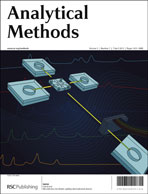Due to their extensive use and wide range of applications, the occurrence of flame retardants in the environment is still a hot issue of environmental interest. An HPLC-APCI-MS/MS method was developed for the simultaneous determination of selected emerging flame retardants in marine sediments. Target flame retardants include α, β, γ-diastereoisomers of hexabromocyclododecane (HBCD), tetrabromobisphenol-A (TBBP-A), anti- and syn-isomers of dechlorane plus (DP) and two novel flame retardants, decabromodiphenylethane (DBDPE) and 2-bis(2,4,6-tribromophenoxy) ethane (BTBPE). The method developed in this work is based on pressurized liquid extraction followed by cleaning of the sample with a silica gel column and then instrumental analysis. The instrumental detection limits ranged between 0.25 ng mL−1 for TBBP-A and 9 ng mL−1 for syn-DP, and the limits of quantification ranged between 0.035 ng g−1 for BTBPE and 0.35 ng g−1 for syn-DP. Accurate quantification of the analytes was achieved by the isotopic dilution technique, which corrects for analyte losses, matrix effects and instrumental fluctuation. The method described here was further applied to South Korean coastal sediment samples. All of the target flame retardants were detected in the sediment samples except for DPs and DBDPE. The detected flame retardants ranged in concentration from 0.06 ng g−1 dw for TBBP-A to 1.43 ng g−1 dw for γ-HBCD.

You have access to this article
 Please wait while we load your content...
Something went wrong. Try again?
Please wait while we load your content...
Something went wrong. Try again?


 Please wait while we load your content...
Please wait while we load your content...